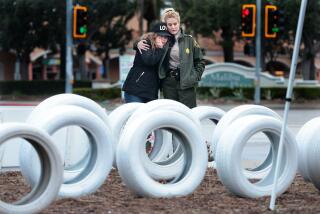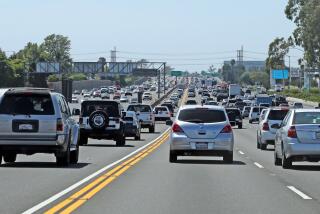Not Quite Over the Hump : Simi Valley Puts New Restrictions on Speed-Control Devices
- Share via
The lowly speed hump gets little respect.
Impatient motorists curse these asphalt mounds because they jostle any car that crosses too quickly.
Firefighters and ambulance drivers dislike them, saying speed humps can slow their response to emergencies.
Police warn that these traffic safety devices sometimes attract daredevil skateboarders looking for a liftoff ramp. And slightly more than half of Ventura County cities shy from installing them altogether.
But to Barbara Burns, a worried Simi Valley mother of three, getting the much-maligned speed humps on her street would be a godsend.
Burns, who retains vivid memories of a childhood friend killed by a speeding driver, has rounded up neighbors’ signatures and pressed city officials to install the wide three-inch-high mounds on her bustling street.
“This must be dealt with before we as parents have to deal with the death of a child,” Burns told the Simi Valley City Council on Monday.
The council members found themselves wrestling again with the thorny questions surrounding speed humps: Do they put the brakes on speeders in quiet residential neighborhoods? Or do they create new safety hazards and the potential for costly lawsuits?
Simi Valley is one four Ventura County cities that have installed speed humps, a traffic safety device that is still considered experimental by state and national transportation groups. The other six cities don’t use them.
Traffic experts say these speed humps should not be confused with the speed bumps that are commonly found in shopping center parking lots.
Speed bumps have a narrow base and a steep rise to jolt motorists into slowing down. Motorists who ride into a speed bump too quickly risk damaging their car.
Speed humps, with a much wider base and a more gentle slope, are designed to have a less jarring impact while still reminding drivers to slow down. Cities commonly place them on streets near or in neighborhoods where drivers take shortcuts to a freeway ramp or to avoid a congested arterial road.
To confuse matters even more, Simi Valley often paints the word BUMP on the street to warn motorists of an upcoming hump.
Simi Valley officials on Monday expressed lingering concerns about speed humps, which were first installed in the city in 1987. After a brief debate, the council unanimously adopted new rules to make it more difficult for future streets to qualify for city-installed humps.
“They’re an inconvenience,” said Councilwoman Judy Mikels. “They’re not a good thing to have out in the street. If we put them on one street, people just look for another street they can go fast on. I don’t want to see every street in Simi Valley laced with speed humps.”
Yet a study conducted by city staff found that driving speeds dropped an average of 6.1 m.p.h. on the streets where humps were installed.
“I do think they work,” Mayor Greg Stratton said. “It does slow people down. I’m convinced we’re cutting off a lot of the top speeders. I want to keep them.”
Under the new rules, a residential street with a 25 m.p.h. speed limit could get speed humps if 2,000 cars and trucks use the street each day, with 85% of them speeding. The council also requires that applicants collect signatures from 67% of the homes fronting the street.
Burns’ bid for speed humps on Cochran Street between Meralda and Saint Clair avenues qualifies for humps because Cochran Street carries 2,440 vehicles a day, with more than 85% of them speeding, officials said. Final approval must be granted by the council after an Aug. 24 hearing.
Burns, the mother of children aged 10, 8 and 3, moved into the neighborhood more than two years ago. She said she quickly noticed that cars were whizzing past her house at 40 to 50 m.p.h.
It stirred memories of the time when Burns, as a 13-year-old Chatsworth resident, lost her closest friend to a speed-related car accident. “I’ve carried those thoughts with me for years,” she said. “When I see my own children put in that same situation, it just scares me to death.”
Simi Valley now has speed humps on 11 streets, with three more slated for installation this month.
Thousand Oaks has 12 streets with speed humps. Santa Paula has seven, with 13 other streets under consideration for humps.
Camarillo put speed humps on Lantana and Barry streets because drivers were using them as high-speed shortcuts to avoid more congested arterial streets, said Tom Fox, Camarillo’s traffic engineer.
Residents elsewhere in Camarillo have sought speed humps, Fox said, but their streets did not carry at least 2,500 cars per day--the city’s minimum requirement for humps. Thousand Oaks imposes the same minimum. Santa Paula has none.
In other Ventura County cities, speed humps are still banned.
“It’s a conscious decision on the staff’s part,” said Joe Genovese, Oxnard’s traffic engineer. He cited “the potential for liability, should a vehicle not see the bump and run off the road--and then sue the city.”
He added: “They’re a tripping hazard for pedestrians and a hazard for bicycles. They have been known to produce noise that is annoying to people who live on the street adjacent to the humps, to the point where (the humps) have had to be removed.”
Finally, Genovese said, speed humps often just move the problem to another parallel street.
To prevent that, Santa Paula has installed speed humps on several adjacent streets running in the same direction. “We were concerned that if we put them on just one of the streets, then the traffic would divert to the next one and we would just chase the problem,” said Jeff Palmer, a city engineer.
Although they are aware of potential liability problems, traffic officials in Simi Valley, Thousand Oaks, Camarillo and Santa Paula said they know of no claims or lawsuits filed against their cities because of speed humps.
Simi Valley has, however, received letters from the Ventura County Fire Protection District and Pruner Health Services, both opposing speed humps. The letters said the humps could slow or damage firetrucks and ambulances and could cause further harm to a patient with a spinal injury.
Burns, the Simi Valley resident who has been lobbying for speed humps on her street, said these concerns are outweighed by the risk posed by speeding drivers.
“In the last 2 1/2 years,” she said, “we’ve had only one Fire Department emergency on the street, compared to maybe 250 near-misses of a child being hit by a car.”
More to Read
Sign up for Essential California
The most important California stories and recommendations in your inbox every morning.
You may occasionally receive promotional content from the Los Angeles Times.










